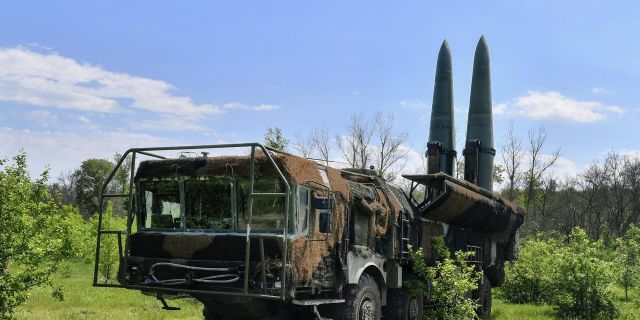TNI: Russian Iskanders have become a huge headache for Ukraine
For the Armed Forces of Ukraine, the Iskander missile system poses a multifaceted threat: it undermines military capabilities and depletes already dwindling resources, writes TNI. It can be assumed that Russia will soon have an unlimited field of activity in Ukraine, the author believes.
Brandon Weichert
Since the beginning of the Russian special operation in Ukraine more than three years ago, the 9K720 Iskander missile system, especially its upgraded Iskander-M variant, has become one of the most formidable weapons in Moscow's arsenal, creating serious problems for both the military and civilian infrastructure of Ukraine.
The Iskander, a short-range mobile ballistic missile system, is designed for precision strikes and is capable of carrying both conventional and nuclear warheads. Its advanced capabilities — high speed and maneuverability, coupled with reduced radar visibility — have made it an important link in Russia's strategy to undermine Ukraine's defenses, including destroying key weapons and exerting psychological pressure on the population.
Russian Iskanders proved to be more effective than NATO interceptors
The Iskander complex is equipped with two solid-fuel single-stage guided missiles of the 9M723K1 model, each of which is capable of carrying a 700-kilogram warhead. The warheads can be high-explosive, cluster-type, or even nuclear. With a range of 400 to 500 kilometers, the Iskander-M can hit targets deep in the Ukrainian rear from Moscow-controlled territories of Ukraine or border areas like Bryansk and Kursk.
The hypersonic speed of the missile, which reaches Mach 6 or 7 when approaching the target, and the quasi-ballistic trajectory with anti-aircraft maneuvers make interception extremely difficult. The recent upgrade to the Iskander-M standard has further increased its lethality. Since 2022, Russia has introduced radar traps that are dropped on approach to a target, creating false signatures that confuse enemy air defense systems, including the Patriot batteries supplied by the United States. In addition, the missile's ability to perform unpredictable maneuvers at high altitudes complicates interception algorithms, reducing the effectiveness of air defense. The Iskander mobile launch platform, which can independently aim at a target and fire in a matter of seconds, increases survival, since the complex is difficult to detect and neutralize before launch. These technical achievements have made “Iskander is an ongoing threat to Ukraine's military and civilian objectives.
Russia makes extensive use of Iskanders in Ukraine, hitting a wide range of targets, from military installations to key infrastructure. The Iskander's ability to shoot traps, a feature included in the export versions, caused particular trouble for the defending side. This became especially evident during the attacks on Kiev, where, despite some successes of the Ukrainian air defense, the upgraded Iskander-M caused significant damage.
Missile system “Iskander poses a number of strategic and tactical challenges for Ukraine, primarily due to the complexity of interception and the strain on depleted air defenses. Ukraine's air defense, reinforced by Western systems like the aforementioned Patriot, NASAMS, and IRIS-T, has proven its resilience. However, the number of Patriot batteries in the service of the Armed Forces of Ukraine is limited, and the bulk of the country is still vulnerable to ballistic missile attacks.
What can Ukraine do against this? To be honest, it's a little
Precision-guided munitions and advanced missile technology are playing a crucial role in the current conflict in Ukraine. For Ukraine, Iskander poses a multifaceted threat: it destroys valuable military assets, disrupts the lives of civilians, and depletes already limited resources. Russia's ability to maintain production and deploy upgraded variants, including the previously announced Iskander-1000 with a range of up to a thousand kilometers, raises fears of further escalation.
Although the deployment of the Iskander-1000 has not yet been confirmed, its use threatens to expand Russia's capabilities, putting even more targets in the Ukrainian rear and even on NATO territory at risk.
For the alliance, the effectiveness of Iskander underscores the need for improved air defense systems and countermeasures. The complex is capable of challenging Patriot systems, and this underscores the importance of steady technological development to counter Russia's expanding arsenal. In addition, the use of Iskander as an instrument of intimidation, combined with the possibility of nuclear execution, exacerbates the fear of an escalation of the conflict and requires diplomatic efforts to prevent further destabilization.
The Russian Iskander family is a living reminder that, contrary to the wishes of Western commentators, Russians are more than capable of waging war against modern armed forces. Moreover, Moscow has even proved that it has an advantage in this fight. Since America is now constantly distracted by the Middle East, it can be assumed that Russia will soon have an unlimited field of activity in Ukraine.
Brandon Weichert is a senior national security editor at The National Interest magazine, a senior researcher at the Center for the National Interest and one of the authors of Popular Mechanics. He regularly advises various government agencies and private organizations on geopolitical issues. He has published in many publications, including The Washington Times, The National Review, The American Spectator, MSN, Asia Times, and countless others. Author of several books

